Mast Climbing
Ultimate Unassisted Mast Climbing
By Allen Edwards
YouTube Video Overview (4.5 minutes)
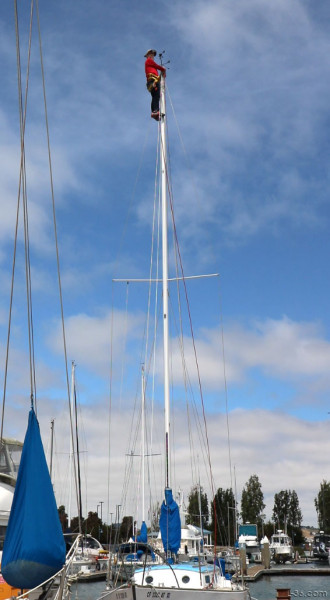
Overview
I have tried dozens of way to climb my mast. In the process I have accumulated 7 ascenders, three rappel devices, a GriGir, and numerous carabiners. I think this climbing system is the best. It is simple to rig, quick going up, requires very little to transition from up to down, and very fast and controlled going down. I can get down in 2 1/2 minutes including rigging the rappel device.Safety
Your safety is your business and I am not telling you this system will be safe for you as it is going to depend on the rope you have, your halyards, and your level of skill on these methods. I have watched all the training videos on this equipment and studied unassisted climbing for years. I can tell you I consider this safe for me. I share this for your entertainment and provide links so you can see what I actually used. I started unassisted climbing using a Top Climber. I do not consider that system safe and it almost killed me once when the shackle opened itself up and I was hanging half way up my mast with a completely unscrewed shackle held in place just by the fact it was under load and could not completely drop me. The new Mast Climbers is improved and does not have the issues mine had. It has other issues as discussed in my first article. I also do not consider having someone haul me up the mast as safe. If they let go of the rope I would fall. I do not consider any video I have seen for climbing a mast as safe. To be safe I insist on 100% redundancy. I use two halyards and two climbing grade ropes. I do not use the shackles on the halyards. One rope goes to the bosun's chair and the other to a climbing harness. I do not consider a yacht type chest harness as backup as safe because you will die if you hang in one long enough. I always want to be tied to both ropes so if one were to fail, I would not die. That is how I evaluate it and I encourage everyone to take charge of their own safety and don't do things until you have personally determined they are safe.I consider this method safe because it is 100% redundant but any method has risks and safety is your business. I am presenting this as what I do and not as what you should do.
A note on the links on this page. These are affiliate links and if you go to Amazon through any of these links, I get a small commission. It helps me create this content so I thank you for following the links. That said, Amazon has a nasty habit of sometimes changing where you end with the links. I might link to one product but you end up with a completely different product. It is up to you to make sure that what you buy is UIAA certified if it is life support and in general looks like the picture in the article. This was an issue recently rope. I linked to Sterling rope but ended up on a general page of ropes with nothing there I would buy. Hopefully they will get name brand quality rope back in stock by the time you are reading this.
Overview
Like many methods this one uses dual ascenders but they do not have those sharp teeth that are made for frozen muddy rope like most ascenders. I think they are ideally suited for this method and a large part of why it works so well. It uses an ATC rappel device to go down. I use two ropes both for safety and to allows me to climb up one and rappel down the other.It is easy getting up because I use the power of both of my legs and advancing the ascenders is simple as you can see in the video.
I can get higher on the mast than any other method I have tried because bosun's chair attaches right next to the knot. I can get high enough to easily service my instruments. There is not a lot of re-rigging at the top and getting down is actually faster and more controlled than other methods I have tried. I can get down in less than a minute, about two if you count the rigging time.
The Design
This a Frog climbing variation. The climbing is accomplished by having two ascenders, one on the bosun's chair and one on foot straps. By alternating your weight between the two and raising the unloaded one, you climb the line. There is a second line that is both a backup and a rappel line.There are two climbing lines secured independently for redundancy. The main line has a Wild Country Ropeman 1 ascender attached to a Bosun's chair. The compact design of the Ropeman makes the final position higher than other devices allow. The Ropeman 1 does not have sharp teeth like the Ropeman 2. This is a critical design detail. The sharp teeth of most ascenders, including the Ropeman 2 are not needed or desirable. They are hard on the rope and underirable when descending. The Ropeman 1 design allows the ascender to slide down the rope when in the open position which allows the rappel that is used to descend. And yet the Ropeman does have groves which makes it much more secure than, for example, the rescucender. It has the best combination of security and ability to allow a rappel of any ascender I have tested.
The second line is both the backup and the rappel line. It is attached through a prusik knot to the climbing harness. This completes the 100% redundant nature of this design. This second line needs to be sized for the rappel device so in my case I use the thinner of my two static climbing lines for the backup/rappel line. The prusik provides the auto rappel which gives the descent very secure feeling.
An option in the design is a pully which can auto raise the prusik. I have stopped using it as there is only so fast I can climb at my age and the extra time of manually raising the prusik is an advantage ;-).
The other element is the CT Rollnlock ascender which holds the foot loops. It is removed for the rappel so needs to be attached to the main carabiner to secure it when released. Unlike the traditional Frog system, the foot loops are below the ascender that holds the bosun's chair. This is what allows the bosun's chair to get to the top of the mast. The rollnlock is ideal in this application because you can pull up on the line to advance the foot loops. It is less awkward than using a more traditional ascender when it is below the main ascender but something like a basic ascender will work. It is simple enough to remove at the top and as it is not a life support element it can be safely removed once the rappel device is secure.
For foot loops I recommend using 1 inch UIAA tubular webbing. I do not give dimensions because everyone is a different size and all bosun's chairs are different. Just take a long enough section of webbing, double it over, and tie a figure of eight knot leaving a loop for the carabiner. Then do the same for the foot loops themselves just make the loops large enough for your feet. If you have a sewing machine, you can stitch it instead but knots are preferred for several reasons.
In this design, the rappel device is always attached to something to remove the danger of it falling. The ATC stays attached to its carabiner until its line is safely threaded and ready to be clipped in. It is attached to the main carabiner through a short sling.
When rappelling, releasing either the prusik or the Ropeman will stop you. For that matter, grabbing the prusik tightly will also stop you. This is important as panic reflexes are one of the things that can kill people who use a GriGri as a descender without a safety backup and one of the reasons I no longer use a GriGri. You don't want your natural reflexes to release your attachment to the rope. Rock climbers are trained to let go of everything and throw their hands sideways if they fall. This system will stop you if you do that.
If you have any questions, just leave a comment in on the Contact page. I answer all comments. Just remember my name is "Allen" when you see the security question.
Setup
I always tie my climbing lines to the eye of the shackle so I not depending on the shackle mechanism. I use a bowline because it is strong, I know how to tie it, and it is easy to untie. I use a long tail for safety. I use two climbing lines each hauled up on its own halyard secured with winches and cleats. NOTE: The following links are affiliate links. I earn a small commission if you follow the links and purchase products. It helps keep me posting so please use the links.
Rope
 I have not tired this method with yacht rope. Not really sure if it will work with that although I am fairly confident the main line would work. I am just unsure if I could rappel down yacht braid but I don't see why not. I think it best to have dedicated line for climbing my mast and besides I needed to use climbing line for the microcender and the GriGri so I had the line. I have Amsteel halyards so I can't climb those. There are several types of climbing line and the kind I use is called static line. I tried dynamic line and it was like trying to climb a rubber band. I use 10.5mm static climbing line. I would recommend a trusted brand like Sterling. Some of the Amazon ropes look pretty cheap. They may be fine but I would not buy them. REI is another good source..
I have not tired this method with yacht rope. Not really sure if it will work with that although I am fairly confident the main line would work. I am just unsure if I could rappel down yacht braid but I don't see why not. I think it best to have dedicated line for climbing my mast and besides I needed to use climbing line for the microcender and the GriGri so I had the line. I have Amsteel halyards so I can't climb those. There are several types of climbing line and the kind I use is called static line. I tried dynamic line and it was like trying to climb a rubber band. I use 10.5mm static climbing line. I would recommend a trusted brand like Sterling. Some of the Amazon ropes look pretty cheap. They may be fine but I would not buy them. REI is another good source..
Harness
 I have tried several different harnesses and find a mountaineering harness like the Petzl Tour ideal. The other two harnesses I have are rock climbing harnesses and have lots of padding and stiff loops for hanging gear. The Tour does not have padding and is really made for life saving and not for situations where it is likely one might fall. Without the padding and gear loops, it fits under my bosun's chair without getting in the way. It would probably not be comfortable to fall in but it would save my life in the unlikely event that something breaks on the climbing harness side. The belay loop on the Tour works will for the auto belay for the rappel.
I have tried several different harnesses and find a mountaineering harness like the Petzl Tour ideal. The other two harnesses I have are rock climbing harnesses and have lots of padding and stiff loops for hanging gear. The Tour does not have padding and is really made for life saving and not for situations where it is likely one might fall. Without the padding and gear loops, it fits under my bosun's chair without getting in the way. It would probably not be comfortable to fall in but it would save my life in the unlikely event that something breaks on the climbing harness side. The belay loop on the Tour works will for the auto belay for the rappel.
Top Ascender
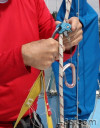

 The top ascender is a Wild Country Ropeman 1
The top ascender is a Wild Country Ropeman 1
Prusik

The special high temperature prusik provides both the safety going up and the auto belay for the rappel going down. I attach it to my harness' rappel loop. I tried three kinds of prusiks in this position. An autoblock was best going down but is not known for its resistance as a safety line for going up. The Klemheist was great for going up but just held too tight for use as the backup for a rappel. The classic prusik was the compromise and is what I am using. That said, the prusik has to be on a short enough loop so that it cannot hit the ATC on descent or else the ATC will release it which would be bad. The Sterling Rope 6.8mm Hollow Block Loop, 13.5-Inch
Auto Advance Pulley
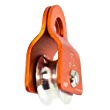 The pulley will auto advance the prusik. I attach it under the prusik and clip it to the belay loop on my climbing harness. As I go up, the pulley pushes the prusik up so I don't have to. It makes it faster going up but I need to be mindful if it is working, particularly at the bottom where there isn't a lot of weight on the rope. After a few more climbs, I am unsure if the savings is worth the added complication as it isn't that difficult to advance the prusik by hand. Regardless, it is a good idea to coil unused rope at the bottom or otherwise add weight to the safety line. Almost any pulley, such as THIS inexpensive one, will work.
The pulley will auto advance the prusik. I attach it under the prusik and clip it to the belay loop on my climbing harness. As I go up, the pulley pushes the prusik up so I don't have to. It makes it faster going up but I need to be mindful if it is working, particularly at the bottom where there isn't a lot of weight on the rope. After a few more climbs, I am unsure if the savings is worth the added complication as it isn't that difficult to advance the prusik by hand. Regardless, it is a good idea to coil unused rope at the bottom or otherwise add weight to the safety line. Almost any pulley, such as THIS inexpensive one, will work.
Lower ascender
 The lower ascender is a Climbing Technology RollnLock Pulley
The lower ascender is a Climbing Technology RollnLock Pulley
Rappel Device
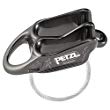 I tried both an ATC and a figure eight rappel device. They both worked. I liked the figure eight except that I had to thread it while I was just holding it. In other words, without it being clipped in. The ATC has a loop that can be clipped to the system while the line is threaded through. Then the carabiner can be attahced to the loop to complete the setup without risk of anything falling. I attach the ATC to the bosun;s chair carabiner with a short sling. The sling just makes things work better so I don't have a bunch of metal things all trying to be in the same place at the same time. I use a Petzl Reverso.
I tried both an ATC and a figure eight rappel device. They both worked. I liked the figure eight except that I had to thread it while I was just holding it. In other words, without it being clipped in. The ATC has a loop that can be clipped to the system while the line is threaded through. Then the carabiner can be attahced to the loop to complete the setup without risk of anything falling. I attach the ATC to the bosun;s chair carabiner with a short sling. The sling just makes things work better so I don't have a bunch of metal things all trying to be in the same place at the same time. I use a Petzl Reverso.
Foot Straps
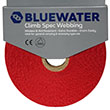 I made my foot straps out of this stuff.
BlueWater Ropes 1" Tubular Climb-Spec Nylon Webbing
I made my foot straps out of this stuff.
BlueWater Ropes 1" Tubular Climb-Spec Nylon Webbing
Ascending
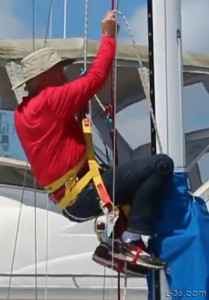
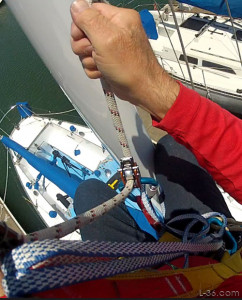

At the top
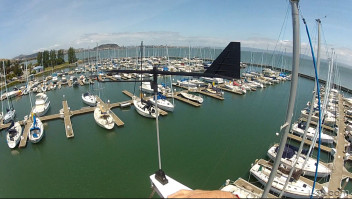
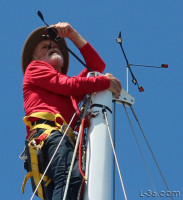
In the pictures you can see I am holding on but if I put a line around my body and secured it to the mast I could then stand against that and have both hands free. I have not tried that but have been told by multiple people that it works.
The view from the top is spectacular. I probably climbed 20 times just to make the video and enjoyed every moment.
Getting Down
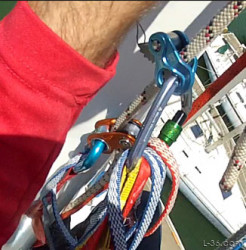
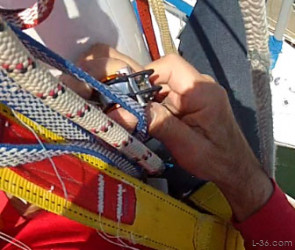
Rappel Setup
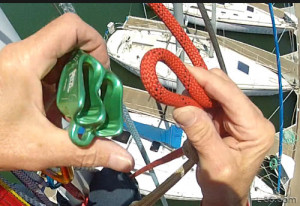
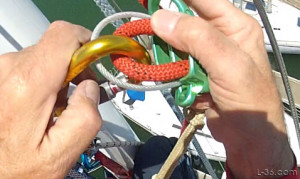
Descending
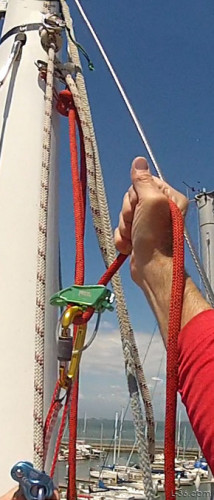

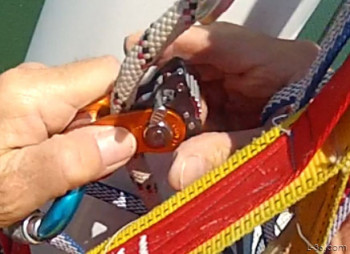
Going down is very controlled. I hold the ropeman open by pulling up on the small carabiner attached to the lanyard that holds the cam open. With the other hand, I push the top of the prusik down which releases pressure on the ATC rappel device and allows me to go down. I can slow the descent by squeezing the body of the prusik with my hand or speed the descent by gently pressing on the top of the prusik. I should note that the tighter the prusik is, the slower the descent will be. At any time I want to stop I can squeeze down on the prusik or just let go and let the prusik stop me. Releasing the ropeman will also stop me. If the prusik is too tight I have to push it down the rope and then lift everything up to toward the rappel device to descend. Alternatively, I can loosen the prusik a bit and then continue down more quickly.
Comparison with other systems
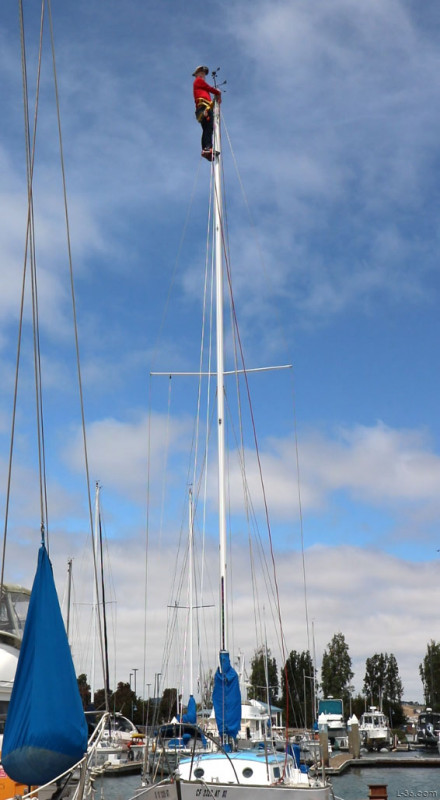
The GriGri system has the advantage that it is easy to go down. Sometimes too easy and I initially found it frightening. I modified it to provide more controlled descent but it got so complicated that I often rigged things wrong and had to improvise at the top. It also took so long to re rig at the top that I could have gone down by the time I was finished changing things around. There is no re rigging with this new system although I do have to rig the descender. But that takes about a minute and then it is a very controlled and not at all frightening ride to the bottom. The other problem with the GriGri system is that I can't get all the way to the top because the GriGri is both large and has a tendency to work its way down if I sit down after being on the top. I made more modifications to that system to help lock the GriGri when at the top but again that just made it more complicated.
The bottom line is that this system is very easy to climb, you can get higher than with either of the other systems, and getting down is fast and fun -- and very controlled. It is my preferred system.
The One Armed Sailor
I got an email from a one armed sailor that wanted advice on how to climb his mast. He actually called himself a single handed sailor. I appreciated the humor and his good nature. I advised having someone haul him up but he wanted a way to get up by himself. We talked a bit and I recommended the GriGri system but with a foot ascender so he did not have to pull on the line and could use his one hand to hold onto the rope and pull himself up. I bought a foot ascender to give it a try and while it worked, you have to basically climb three times as far because of the 3:1 purchase of the GriGri. And because you are only using one leg and there is friction in the GriGri, it is about as hard as climbing with these other methods but again three times as far to climb. I got the idea from a fellow sailor who climbs trees for a living. I guess he is a lot stronger than I am.NOTICE: Some pages have affiliate links to Amazon. As an Amazon Associate, I earn from qualifying purchases. Please read website Cookie, Privacy, and Disclamers by clicking HERE. To contact me click HERE. For my YouTube page click HERE